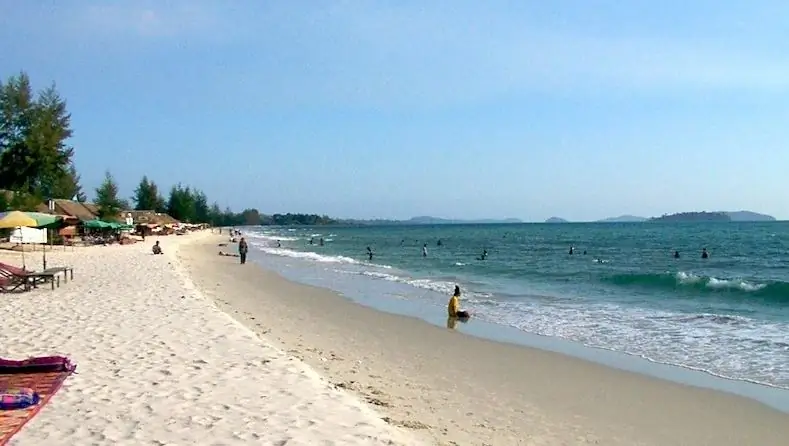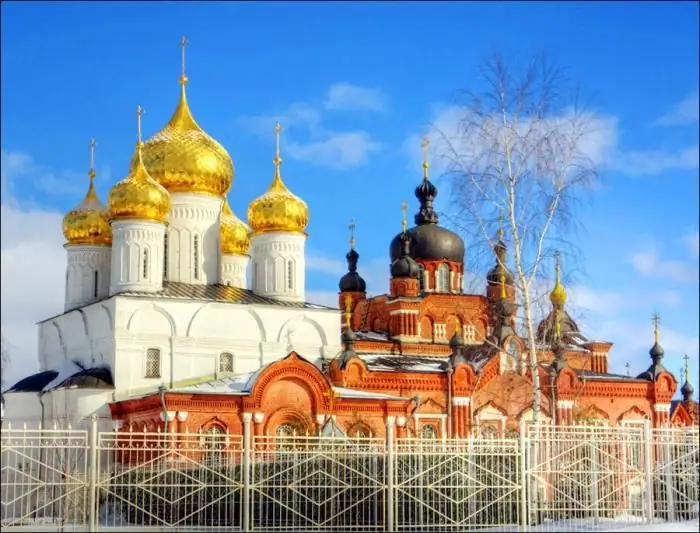- Author Harold Hamphrey [email protected].
- Public 2023-12-17 10:06.
- Last modified 2025-01-24 11:10.
On the bank of the Kuibyshev Reservoir, at the mouth of the Bolshoy Cheremshan River, the second largest administrative center of the Ulyanovsk Region, the city of Dimitrovgrad, is located. It occupies an area of 113.97 sq. km. The city has 118.5 thousand inhabitants.

The first settlements on this land between the Volga and Cheremshan appeared in the 17th century. In the 80s of the last century, the formation of a modern city began. At the same time, Dimitrovgrad was divided into two districts: Western and Pervomaisky. The first is the historical part, where the buildings of pre-revolutionary buildings are located. The second district was built after the war.
Today, Dimitrovgrad is the largest nuclear center in Russia. There are many industrial enterprises, factories and factories here. In each district of the city, infrastructure has been thought out that meets modern requirements for comfortable living. The long and interesting history of the city is reflected in its memorable places.

Sights of Dimitrovgrad: description and photo. Gagarin Street
The central and most visited street of the city, which has turned into an open-air museum. All buildings here are stylized as antiques, original lanterns and flowerpots are installed, mini-museums operate in many institutions. All this recreates the extraordinary. atmosphere of a 19th century city.
Local History Museum
In 1964, N. I. Markov created and for many years headed the city museum of local lore. The basis of its collection was made up of exhibits that were collected in the 50s of the last century by the famous local historian S. G. Dyrchenkov. The exhibitions “From the Past of Melekess Posad”, “Nature of the Native Land”, “Master Cluster”, “Live Earth”, “Melekessians in the Battles for the Motherland” arouse great interest of the townspeople and guests to this attraction of Dimitrovgrad. The museum's funds include over 23 thousand exhibits. This is a major center for the study, collection and storage of valuable materials on the history of the city.

SSC Research Institute of Atomic Reactors
One of the main attractions of the city of Dimitrovgrad in the Ulyanovsk region is this city-forming enterprise. The institute operates six nuclear research reactors, Europe's largest nuclear reactor core research facility, a nuclear fuel cycle R&D facility, a radioactive waste management facility, and a radiochemical facility.
Savior Transfiguration Church
The cult landmark of Dimitrovgrad in this review is a temple erected onplace of St. Nicholas (White) Church, destroyed in the 30s of the last century. The construction of the church on the donations of parishioners began in 2004, and already in 2007 it was consecrated in the name of the Transfiguration Savior.
After the formation of independent Cherdaklinskaya and Melekessky dioceses, the Transfiguration Church received the status of a cathedral. A Sunday school operates at the cathedral parish, conversations are held with those wishing to accept the rite of baptism, and active social activities are carried out.

Drama Theatre. A. N. Ostrovsky
A magnificent monument of culture, architecture, history of Dimitrovgrad. You can see a photo of the attraction in this material. At the request of the Posad Duma in 1908, this building was built as the People's House, at the expense of the city treasury and private donations.
The authors of the project were Samara architects I. M. Krestnikova and A. Voloshina. The building is made in eclectic style. Until now, it has preserved its external features, internal layout. This is a red-brick two-story building on a small plinth lined with figured bricks.

Two risalits and gothic towers on the upper ledges of a rectangular shape, the facade is decorated with narrow high paired windows in the form of an arch. Now famous directors stage performances in the theater, which attracts a wide audience here.
Monument "Airplane"
I must say that the inhabitants of the city are very sensitive to the sightsDimitrovgrad in the Ulyanovsk region, associated with the memory of the fallen heroes.
Monument dedicated to the pilots who gave their lives in the Battle of Kursk. 317 residents of Dimitrovgrad took part in one of the most difficult battles near Kursk. Fifty-five heroes are buried on the Kursk Bulge. The monument was erected in the city in 2003 by architects E. Suslin and T. Tarasov.

Monument "Eternal Glory"
The memorial is a tribute to the memory of the soldiers who died during the Second World War. It was opened on the eve of the 30th anniversary of the Great Victory (1975). In the pedestal of this important landmark of Dimitrovgrad for the townspeople, two capsules with a letter to descendants and sacred land were immured, which the Komsomol members of the city brought from the places of heroic battles where their heroic countrymen died.
Monument to the Victims of Radiation
In our opinion, the appearance of such a monument in the city of nuclear scientists is quite justified. The monument to all those who suffered in radiation disasters has taken its rightful place on the Walk of Fame. Over 700 residents of the city, as well as the Melekessky district, took part in nuclear tests in Semipalatinsk, in the aftermath of the terrible accident at the Chernobyl nuclear power plant and the Mayak association.
42 liquidators received high government awards, 192 became disabled, 207 people died from the effects of radiation exposure. In the Ulyanovsk region, the tragedy of Chernobyl affected more than five thousand people.

Monument to I. A. Goncharov
Sights of Dimitrovgrad (Russia) include monuments and bas-reliefs dedicated to famous military leaders, travelers, writers. The monument to I. A. Goncharov, the famous Russian writer, is installed in the park at the intersection of Dimitrov Avenue and Goncharov Street. Three of his novels are most famous and popular - Oblomov, The Cliff, Ordinary History. The sculpture was donated to the city by the local history museum of Ulyanovsk.
Monument to merchant Markov
The iconic landmark of Dimitrovgrad was installed in the city in 2003. It is noteworthy that the monument was created with donations from the townspeople. K. G. Markov is the first city head who ruled Melekess (now Dimitrovgrad) for 40 years. He did a lot for its development and prosperity.
Markov was a philanthropist and philanthropist. An interesting fact: by 1915, Melekess was one of the few cities in Russia that did not have debts. On the contrary, he had capital in the amount of 340 thousand rubles. Konstantin Grigoryevich actively participated in the October events of 1917 - he was an opponent of the dispersal of the Duma, but on March 12 it was dissolved, and a new executive committee was elected, accusing him of hostile activity, removed him from his post and advised him to leave the city forever.

According to the verdict of the revolutionary tribunal in 1919, Markov was shot. At that time he was over 70 years old.
Monument to the ruble
The original attraction of Dimitrovgrad is undoubtedly this art object. This is the very first in the worldmonument to the monetary unit of Russia. It was installed in 2004 and timed to coincide with the 300th anniversary of the start of the regular minting of the ruble, which was established by Peter I.
The monument is made of metal and is a double two-meter capital letter "P", which is enclosed in a circle, fixed on three masts. They are painted in the colors of the Russian flag.






